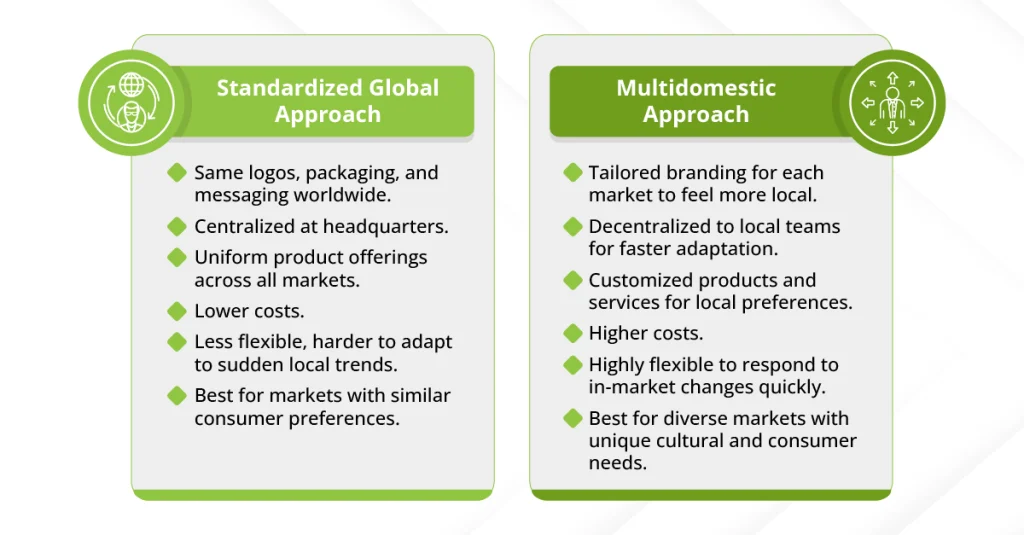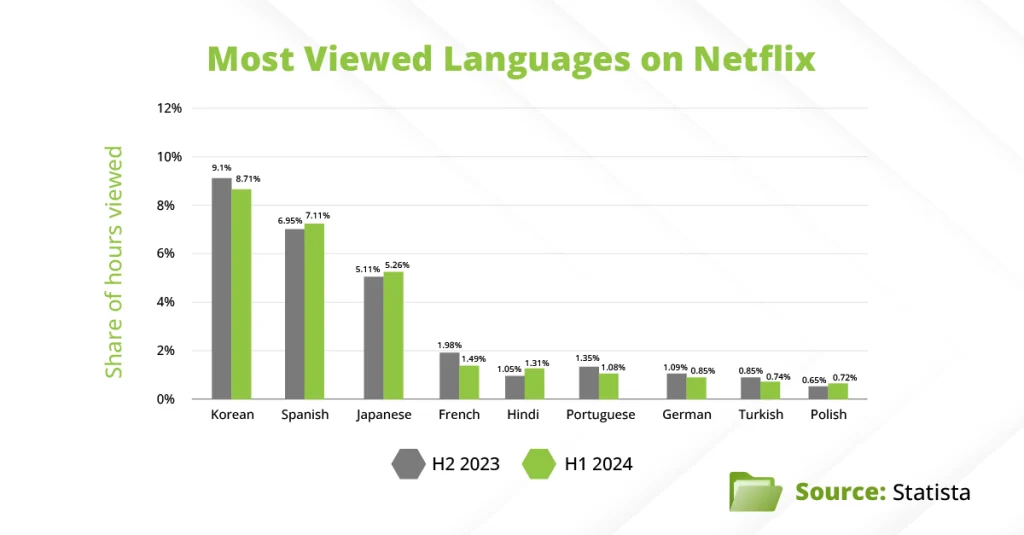Did you know there are two very different approaches to brands going international? Both can be successful, but which one is the right fit for your brand?
Some global brands choose to present themselves in the same way worldwide, with minimal adjustments for local cultures. Think of Apple or Google: you’ll notice consistent branding almost everywhere.
Other brands take a different route, creating multiple versions of the parent company for each market. This kind of immersion in the local market allows them to compete head-to-head with local competitors. Examples include McDonald’s, Starbucks, and Netflix.
This second approach is called a multidomestic strategy. Let’s explore what it is, how it works, and when your brand should consider using it.
What Is a Multidomestic Strategy and Why Does It Matter Today?
A multidomestic (or multi-domestic) strategy means adapting your products and services to meet the cultural, regulatory, and consumer expectations of each local market.
It’s a shift from a one-size-fits-all global strategy to one that prioritizes local responsiveness. When executed well, this approach can be the key to success in international markets.
Global brands like McDonald’s and Unilever have mastered this strategy, tailoring their products to local tastes and winning massive market share as a result.

What Makes a Multidomestic Strategy Unique?
A multidomestic strategy empowers local markets by allowing country-specific teams to shape branding, pricing, and operations for their audience. Here’s what sets it apart:
– Low global integration, high local responsiveness
- Decision-making happens at the local level, not at corporate headquarters.
- Each market operates like a semi-independent unit to better meet local needs.
– Autonomy for local business units
- The parent company delegates authority so teams can adapt fast and build consumer trust.
Focus on matching local preferences
- Branding, packaging, and pricing are customized for each market.
- Cultural nuances and consumer behavior shape every decision.
– How it compares to other strategies
- Unlike centralized global strategies or hybrid (transnational) models, a multidomestic approach prioritizes local fit over global uniformity.
By giving local teams the power to act fast and adapt deeply, this strategy helps brands create strong connections in diverse markets.
Why Localization Is Central to Multidomestic Success
At the heart of a multidomestic strategy is a good and continuous localization process.
Here’s how localization drives success:
- Supports Local Culture and Standards
- Content (including visuals) and products are adapted to reflect cultural preferences, comply with local regulations, and meet language expectations.
- Content (including visuals) and products are adapted to reflect cultural preferences, comply with local regulations, and meet language expectations.
- Adapts Every Touchpoint for the Target Market
- From user experience (UX) and packaging design to help content and branding, localization ensures every detail resonates locally.
- From user experience (UX) and packaging design to help content and branding, localization ensures every detail resonates locally.
- Empowers Localization Teams on the Ground
- Skilled localization teams act as cultural and linguistic experts, enabling businesses to build local brands under global ownership.
- Skilled localization teams act as cultural and linguistic experts, enabling businesses to build local brands under global ownership.
- Tactical Implementations That Drive Results
- Services like website localization help brands deliver seamless online experiences.
- eLearning localization ensures training and onboarding content is accessible across regions.
- Services like website localization help brands deliver seamless online experiences.
Did you know? Only 26% of Internet users understand English.
Whether launching an app in Indonesia or onboarding teams in Germany, effective localization fuels a successful multidomestic strategy.
The Business Benefits of Going Multidomestic
A multidomestic strategy isn’t just about operating in different countries—it’s about building stronger connections with each local market. This approach creates real value for businesses in multiple ways:
- Tailored Marketing Builds Relevance and Trust
- Customizing campaigns for each market ensures your products and services align with local values, languages, and cultural expectations.
- Customizing campaigns for each market ensures your products and services align with local values, languages, and cultural expectations.
- Faster Local Adaptation Speeds Time-to-Market
- Local teams can respond quickly to changing trends and consumer demands without waiting for centralized approvals.
- Local teams can respond quickly to changing trends and consumer demands without waiting for centralized approvals.
- Competitive Advantage Through Authentic Experiences
- Delivering experiences that feel truly local helps brands stand out from global competitors relying on generic messaging.
- Delivering experiences that feel truly local helps brands stand out from global competitors relying on generic messaging.
- Simpler Regulatory Compliance
- Managing compliance at the local level makes it easier to meet region-specific laws and standards.
- Managing compliance at the local level makes it easier to meet region-specific laws and standards.
- Greater Flexibility in Market Strategy
- Real-time feedback from in-market teams enables businesses to pivot strategies and improve products and services faster.
- Real-time feedback from in-market teams enables businesses to pivot strategies and improve products and services faster.
You don’t build loyalty by broadcasting—you earn it by speaking your customer’s language, values, and expectations.
Who’s Doing It Right? Global Brands Winning Locally

The best proof of a multidomestic strategy’s success comes from brands that have mastered it. These companies demonstrate how tailoring products and experiences to each local market drives growth and loyalty.
- McDonald’sMcDonald’s adapts its menus worldwide to suit local tastes, from the McArabia in the Middle East to vegetarian options in India. Its culturally adapted campaigns make it a familiar brand in each market.
- NestléNestlé takes a region-specific approach to sourcing, labeling, and product portfolios. Its chocolate flavors, coffee blends, and packaging designs often vary to match cultural preferences and regulatory standards.
- NetflixNetflix excels at delivering localized content libraries, subtitles, and culturally relevant marketing campaigns. Two of its most popular shows, La Casa de Papel (Spanish) and Squid Game (Korean), were created for local audiences, yet they went on to captivate viewers worldwide.

Balancing Local Freedom and Global Consistency
A multidomestic strategy gives brands the agility to adapt locally, but it also brings challenges that can undermine success if left unchecked.
- One major risk is brand inconsistency. When local teams are given full autonomy, messaging and design can stray from the parent company’s global identity.
- Another challenge lies in losing economies of scale. Decentralized marketing and production often mean higher costs compared to standardized global operations.
The solution lies in balance. By developing unified brand playbooks, companies can empower localization efforts while preserving core brand values.
Strong vendor partnerships and technology-enabled localization workflows also help ensure consistency without sacrificing speed and flexibility.
A great multidomestic strategy allows freedom to localize, without losing sight of global brand integrity.
Is a Multidomestic Approach Right for Your Business?
A multi-domestic approach works best for businesses where success depends on deep cultural relevance and strong local connections.
Industries like retail, healthcare, SaaS, and eLearning often see the most value from this model. Each target market in these sectors comes with unique cultural, regulatory, and linguistic demands that can’t be met with generic global strategies.
To make a multidomestic strategy work, companies need the ability to scale localization without central bottlenecks.
This means empowering in-country teams, building strong local partnerships, and leveraging existing assets, like translation memory or trusted vendors, to move faster and farther.
If your products and services rely on connection, not just reach, a multidomestic strategy may be your best move.
Ready to Launch a Multidomestic Strategy That Works Globally and Locally?
A successful multidomestic strategy needs more than localized content; it needs a partner who understands how to scale across diverse markets without losing your global brand identity.
At bayantech, we bring together native linguists, ISO-certified workflows, and 20+ years of experience helping global businesses succeed in local markets.
Whether you’re adapting a website, training global teams, or planning a full-scale rollout, we’ll help you make it happen—one market at a time.
Take your global business to the next level by making it local.







